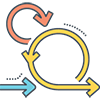Project Management Types

Project Management Types
There are several project management types, each with its own set of characteristics, advantages, and disadvantages. Here are some of the most common project management types and their advantages:
Traditional Project Management
 Also known as the Waterfall method, it follows a linear sequential approach where the project is divided into different phases, with each phase starting only after the previous one is completed. This method is suitable for projects with well-defined requirements and a predictable outcome.
Also known as the Waterfall method, it follows a linear sequential approach where the project is divided into different phases, with each phase starting only after the previous one is completed. This method is suitable for projects with well-defined requirements and a predictable outcome.
Advantages of Traditional Project Management
- Clear objectives: Traditional project management follows a linear sequential approach, where each phase has a specific set of objectives. This makes it easier to define and understand the project scope and requirements.
- Well-defined roles and responsibilities: The Waterfall method has a clear division of labor, with each team member having specific roles and responsibilities. This reduces confusion and increases accountability.
- Predictable outcome: The Waterfall method has a well-defined project plan, with each phase building on the previous one. This makes it easier to predict the outcome of the project, including its cost, timeline, and deliverables.
- Documentation: Traditional project management places a heavy emphasis on documentation, including project plans, progress reports, and final deliverables. This ensures that there is a clear record of the project’s objectives, scope, and outcome.
- Lower risk of scope creep: The Waterfall method has a well-defined scope and requirements, making it less susceptible to scope creep. This helps to control costs and avoid delays.
- Suitable for simple projects: Traditional project management is most suitable for simple, straightforward projects with a clear set of objectives and requirements.
Agile Project Management
 This methodology follows an iterative and incremental approach to project delivery. Agile Project Management allows for flexibility in adapting to changing requirements and encourages collaboration and communication among team members.
This methodology follows an iterative and incremental approach to project delivery. Agile Project Management allows for flexibility in adapting to changing requirements and encourages collaboration and communication among team members.
Advantages of Agile Project Management
- Flexibility: Agile project management is designed to be adaptable to change. It allows for changes in project requirements, priorities, and scope, which makes it easier to accommodate evolving customer needs and market conditions.
- Collaboration: Agile project management encourages collaboration and communication among team members. This fosters a sense of shared ownership and accountability, which can lead to better decision-making and higher-quality deliverables.
- Faster delivery: Agile project management uses an iterative and incremental approach, which allows for faster delivery of working software and other deliverables. This helps to reduce the time-to-market and increase customer satisfaction.
- Improved quality: Agile project management emphasizes continuous improvement and testing throughout the project lifecycle. This helps to identify and correct issues early, which can lead to higher-quality deliverables and fewer defects.
- Customer satisfaction: Agile project management is focused on delivering value to the customer. This helps to ensure that the project meets the customer’s needs and expectations, which can lead to higher customer satisfaction.
- Better risk management: Agile project management uses short iterations and frequent feedback loops, which makes it easier to identify and mitigate risks early in the project lifecycle. This helps to reduce the overall risk of project failure.
Scrum
 A subset of Agile, Scrum is a framework that helps teams deliver products in an iterative manner. It focuses on delivering a small set of functionalities in short sprints, usually lasting 2-4 weeks.
A subset of Agile, Scrum is a framework that helps teams deliver products in an iterative manner. It focuses on delivering a small set of functionalities in short sprints, usually lasting 2-4 weeks.
Advantages of Scrum Project Management
- Increased collaboration and communication: Scrum emphasizes collaboration and communication among team members, which can lead to higher-quality deliverables and better team morale.
- Faster delivery: Scrum uses short iterations called sprints, which typically last 2-4 weeks. This allows for faster delivery of working software and other deliverables.
- Improved flexibility and adaptability: Scrum is designed to be flexible and adaptable to change. It allows for changes in project requirements, priorities, and scope, which makes it easier to accommodate evolving customer needs and market conditions.
- Transparency and visibility: Scrum uses a visual approach, such as a scrum board, to provide transparency and visibility into the project’s progress. This makes it easier for the team and stakeholders to understand the status of the project.
- Focus on value delivery: Scrum is focused on delivering value to the customer. It helps to ensure that the project meets the customer’s needs and expectations, which can lead to higher customer satisfaction.
- Better risk management: Scrum uses short iterations and frequent feedback loops, which makes it easier to identify and mitigate risks early in the project lifecycle. This helps to reduce the overall risk of project failure.
Kanban
 Another Agile methodology, Kanban is a visual approach to project management that emphasizes on continuous delivery, teamwork, and self-organization. It is particularly useful for projects with a high degree of variability in terms of work volume and priority.
Another Agile methodology, Kanban is a visual approach to project management that emphasizes on continuous delivery, teamwork, and self-organization. It is particularly useful for projects with a high degree of variability in terms of work volume and priority.
Advantages of Kanban Project Management
- Increased efficiency: Kanban emphasizes workflow visualization and management, which helps to identify and eliminate bottlenecks in the process. This leads to increased efficiency and faster delivery of work items.
- Improved collaboration and communication: Kanban promotes collaboration and communication among team members, which helps to improve team morale and reduce the risk of miscommunication.
- Flexibility and adaptability: Kanban is designed to be flexible and adaptable to change. It allows for changes in project requirements, priorities, and scope, which makes it easier to accommodate evolving customer needs and market conditions.
- Better resource utilization: Kanban helps to identify and manage resource constraints, which leads to better resource utilization and increased productivity.
- Transparency and visibility: Kanban uses a visual approach, such as a Kanban board, to provide transparency and visibility into the project’s progress. This makes it easier for the team and stakeholders to understand the status of the project.
- Focus on continuous improvement: Kanban is focused on continuous improvement, which helps to identify and eliminate waste in the process. This leads to increased efficiency and higher-quality deliverables.
Project Management Types – Summary
Project management types, each has its own strengths and weaknesses, and the choice of methodology depends on the project’s objectives, scope, and requirements.
